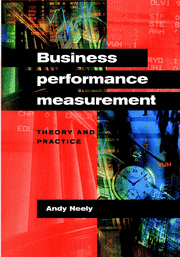Book contents
- Frontmatter
- Contents
- List of contributors
- Preface
- Part I Performance measurement – functional analyses
- Part II Performance measurement – theoretical foundations
- Part III Performance measurement – frameworks and methodologies
- Part IV Performance measurement – practical applications
- 13 What really goes on in the name of benchmarking?
- 14 Measuring marketing performance: Which way is up?
- 15 Loosely coupled performance measurement systems
- 16 Redefining government performance
- Part V Performance measurement – specific measures
- Part VI Performance measurement – emerging issues and trends
- Index
13 - What really goes on in the name of benchmarking?
from Part IV - Performance measurement – practical applications
Published online by Cambridge University Press: 06 July 2010
- Frontmatter
- Contents
- List of contributors
- Preface
- Part I Performance measurement – functional analyses
- Part II Performance measurement – theoretical foundations
- Part III Performance measurement – frameworks and methodologies
- Part IV Performance measurement – practical applications
- 13 What really goes on in the name of benchmarking?
- 14 Measuring marketing performance: Which way is up?
- 15 Loosely coupled performance measurement systems
- 16 Redefining government performance
- Part V Performance measurement – specific measures
- Part VI Performance measurement – emerging issues and trends
- Index
Summary
Introduction
Best-practice benchmarking is today taken to describe a process whereby organizations pursue enhanced performance by learning from the successful practices of others. Comparisons may be made with other parts of the same organization, with competitors, or with organizations operating in different spheres whose business processes are nevertheless deemed to be in some way relevant. By implication at least, the lessons learned are implemented and the cycle continues anew.
The purpose of this chapter is to shed some light on the rather broad range of activities that are often subsumed under the umbrella term of benchmarking. The authors’ original interest in the topic stems from a conviction that benchmarking offers rather more than the mere establishment of performance “league tables.” Although we fully accept the value of these as a means of ascertaining comparative performance levels, and hence directing attention towards areas or processes which are seen, in relative terms, to be under-performing, our conviction remains that true benchmarking entails rather more. Specifically, the network of contacts generated by the activity represents a treasure-trove of good (if not necessarily best) practice, much of which could be adopted by the organization in some shape or form. It has been argued that benchmarking can only be about catching up; if good practice were to be copied slavishly then this would undoubtedly be the case, but a more general receptivity to good ideas, and the willingness to try them out in some new context, is arguably a major ingredient for innovation (see, e. g., Drucker, 1985; Peters, 1989; Zairi, 1996a).
- Type
- Chapter
- Information
- Business Performance MeasurementTheory and Practice, pp. 211 - 224Publisher: Cambridge University PressPrint publication year: 2002
- 10
- Cited by



